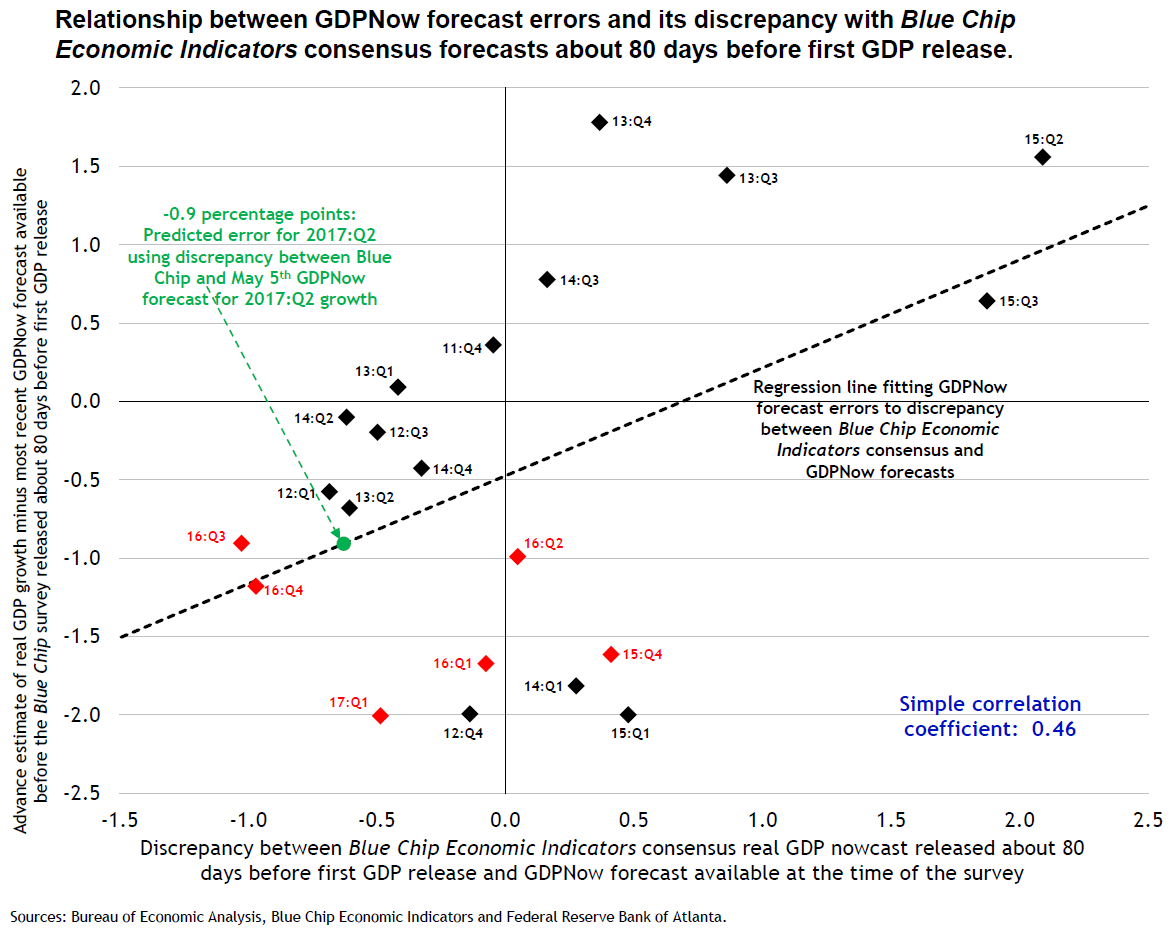Real gross domestic product (GDP) growth slowed from a 2 percent pace in 2016 to an annual rate of 0.7 percent in the first quarter of 2017. The Federal Open Market Committee viewed this slowdown in growth "as likely to be transitory," according to its last statement.
Indeed, current quarter GDP forecasting models maintained by the Federal Reserve Banks of New York, St. Louis, and Atlanta have been pointing toward stronger second quarter growth (2.3 percent, 2.6 percent and 4.1 percent, as reported on their respective websites on May 19, 2017).
The Atlanta Fed's model—GDPNow—is at the high end of this range and is also high relative to other professional forecasts. The median forecast for second quarter real GDP growth in the May Survey of Professional Forecasters (SPF) was 3.1 percent, for instance, and recent forecasts from Blue Chip Publication surveys displayed on our GDPNow page show some divergence from our model as well.
We encourage—and frequently receive—feedback on our GDPNow tool, and some users have suggested that our forecast for second quarter growth is too high. In fact, some empirical evidence supports that view. The evidence considered here correlates differences between consensus Blue Chip Economic Indicators Survey and GDPNow forecasts for growth about 80 days before the first GDP release with the GDPNow forecast errors (see the chart below).
A note about the chart: The horizontal axis shows the difference between the Blue Chip consensus forecasts and GDPNow's forecast. The vertical axis measures the 80-day-ahead GDPNow forecast error, defined as the difference between the first published estimate of real GDP growth and the GDPNow forecast at the time of the mid-quarter Blue Chip survey.
As the chart shows, there is a positive relationship between the Blue Chip-GDPNow discrepancy and the GDPNow forecast error. A simple linear regression would predict that the GDPNow forecast of 3.7 percent growth on May 5 was too high by nearly 1.0 percentage point. Moreover, the chart suggests that there has been a bias in GDPNow forecasts since the fourth quarter of 2015 of between 0.9 and 2.0 percentage points at the time of these mid-quarter Blue Chip surveys. If you are inclined to think the GDPNow forecast for second quarter growth is a bit too high, then this evidence will not change your mind.
Given this evidence, you might think that putting relatively little stock in the GDPNow forecast at this point in the quarter would be prudent. Indeed, if we calculate the weighted average of the historical Blue Chip consensus and GDPNow forecasts that produced the most accurate forecast of the first estimate of real GDP growth, then the optimal weight of the GDPNow forecast lies somewhere between 0.34 and 0.55 (see the chart below). The weight depends on the number of days until the first GDP release.
For example, the optimal weight of 0.55 on GDPNow about 54 days before the first GDP release means that 0.55 times the GDPNow forecast plus 0.45 times Blue Chip consensus survey forecast has been more accurate, on average, than any other weighted average of the two forecasts. The lowest weight on GDPNow corresponds to forecasts made about 83 days before the first GDP release—the time when GDPNow's bean-counting algorithms have the least amount of source data to work with.
A weighted average of the Blue Chip consensus and GDPNow forecasts at that time would put the GDP forecast about 0.6 to 0.7 percentage points below the current GDPNow forecast. However, the confidence bands around these estimates are wide, so the positive weight placed on GDPNow early in the quarter could just be the result of chance.
Let's cut to the chase—why, exactly, is the GDPNow forecast for second quarter GDP growth so high? The details of the GDPNow forecast provide some clues. We can compare the GDPNow forecasts of GDP components with those from the SPF. (The Blue Chip forecast does not provide detail on all the GDP components.) The following table translates the median SPF forecasts into contributions to second quarter real GDP growth. These contributions are shown alongside GDPNow's forecasted contributions as well as the average contributions to real GDP growth over the prior four quarters.
Clearly, more than half of the difference between the GDP growth forecasts from GDPNow and the SPF is due to inventories. For both forecasts, inventory investment also accounts for over half of the pickup in second quarter growth from the trailing four-quarter average.
A macroblog post I wrote last year showed that the growth-forecast contribution of mid-quarter inventory investment produced roughly equivalent accuracy in the SPF and GDPNow models, but it was much less accurate than the contribution forecasts of the other GDP components. Based on experience, we can't be confident that either forecast of inventory investment is likely to be very accurate or that one is likely to be much more accurate than another.
With very little hard data in hand for the second quarter for most of the GDP components—and for inventories in particular—we will continue to closely monitor if the data are as strong as GDPNow is anticipating or if they hew more closely to other forecasts. Check back with us to see.




 By
By